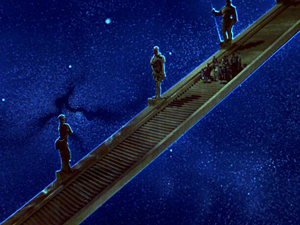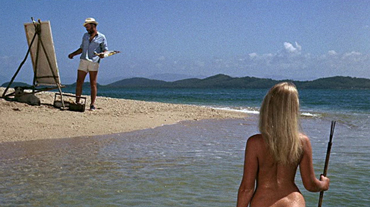
 |
|
|
|
Sony's The Films of Michael Powell combines two of the revered English filmmaker's most difficult-to-see features, a lavish Technicolor fantasy from 1946 and the director's final film, a sunny idyll about art and creativity on Australia's Great Barrier Reef.
A Matter of Life and Death
Michael Powell and Emeric Pressburger came into their own making wartime movies that didn't fall into the accepted definition of propaganda. Instead of stern morale-builders about sacrifice to the flag, their "Archers" films criticized cultural contradictions in the military (The Life and Death of Colonel Blimp) and in the countryside (A Canterbury Tale) in a way that promoted the English way of life as something worth preserving. A Matter of Life and Death (re-titled Stairway to Heaven for America) was produced just as the war ended. An unusually creative fantasy that strains the limits of color technology, it's also the closest the Archers came to a standard message picture, with an overt intent to propigate postwar harmony between England and the United States. 
Representing the two countries are Brit flier Peter Carter (David Niven) and American WAC June (Kim Hunter). They meet and fall in love over the radio, when Peter reports that he's about to bail out of a plane with no parachute. He wakes up on a beach, alive but suffering from concussion damage that Doctor Frank Reeves (Roger Livesey of I Know Where I'm Going) plans to cure with a risky brain operation. But Peter experiences the crisis in the form of bizarre hallucinations in which a heavenly emissary known as Conductor 71 (Marius Goring) arrives to escort him to the afterlife. Peter refuses to go with the 18th century French dandy, arguing that his miraculous survival and romance with June are events that Heaven didn't count on, and shouldn't revoke. As Peter is wheeled into the operating room, a celestial court convenes to determine his fate.
The premise is an elaborate variation on the film blanc form, that fantasy subgenre dealing with heavenly waiting rooms and "lost souls" in limbo between terra firma and the heavenly gates. Reversing the particulars of Here Comes Mr. Jordan, Powell and Pressburger's script shows the heavenly bureaucracy dealing with a mix-up that leaves a mortal alive when he should be dead. In this case, Earth is in Technicolor, and Heaven in B&W. A properly ethereal angel (Kathleen Byron of Black Narcissus) dressed as a servicewoman presides over
Heaven is populated by multitudes from every culture and time period, which accounts for Conductor 71's presence as Peter's personal contact man. Marius Goring is given the film's most famous line, upon arrival in the full-color real world: "Ah, how one is starved for Technicolor up there!" Peter's trial prosecutor is a Yankee patriot from the American war of independence, the stern Abraham Farlan (Raymond Massey). Farlan would rather not see June, a daughter of Boston, entangled with a no-account Englishman who ought to be dead. Thanks to Alfred Junge's designs the fantastic heavenly trial is a wonder to behold, but it's also the weakest part of the film. Powell and Pressburger were asked to counter grumblings in the U.S. government that America shouldn't be aiding a monarchy ruling over a far-flung empire. The spirited debate simply acknowledges that the two countries are bound by similar values. The film's real climax comes with a replay of the cosmic dilemma from Fritz Lang's silent Destiny (Der müde Tod): faced with a terrible decision, June volunteers to take Peter's place in the afterworld.
Powell's visual imagination makes A Matter of Life and Death a sheer wonderment, aided immensely by Jack Cardiff's Technicolor artistry. Live action is routinely combined with matte overlays of abstract artwork. Dramatic scenes are accompanied by splashes of expressive color, reds and yellows that suffuse the film frame with a stylized
The big illusions take place in heaven, dominated by a stone escalator that stretches into a galactic infinity. When the two domains meet, B&W combines with full color in several shots. Disembodied ghosts "walk through a wall" in what must have been a very difficult traveling matte. A pink rose marks transitions between worlds, and conveys the tears that prove June's love. Powell and Pressburger's penchant for eccentricity doesn't loosen their film's grip on our emotions. Peter and June have formed a spiritual bond that heaven cannot, as they say, pull asunder. The most memorable images remain the enormous Technicolor close-ups of David Niven and particularly Kim Hunter, radiant in the center of the miracles. A Matter of Life and Death is a playful, reassuring transition between the tragedy of war and the hopes for the future. Age of Consent1969 / 106 98 min / 1:85 anamorphic widescreen Starring James Mason, Helen Mirren, Jack MacGowran, Neva Carr-Glyn Cinematography Hannes Staudinger Film Editor Dennis Gentle Original Music Peter Sculthorpe Written by Peter Yeldham from a novel by Norman Lindsay Produced by James Mason, Michael Pate, Michael Powell Directed by Michael Powell
The bright and breezy Age of Consent was released in 1969, twelve years after the Powell-Pressburger creative breakup. It comes from another era altogether, when Powell's directing career was coming to a close. Produced by its star James Mason from a book written in the 1930s, Peter Yeldham's screenplay follows celebrated artist Bradley Morahan (Mason) on a retreat to a remote island to recharge his creative batteries. Bradley is pursued by a rascally
Age of Consent presents the beautiful and uninhibited Cora as the key element in Morahan's beachcombing paradise. In the midst of her self-discovery as a sexual being, Cora must dodge the repressive fury of her witch-like mother (Neva Carr-Glyn). She poses in the nude for Morahan, happy to be earning money and intrigued to see her body transformed into artworks. Cora dives to the reef, becoming an erotic aquatic sculpture for Bradley's sketches.
The newly adopted ratings system opened a flood of gratuitous nudity in mainstream filmmaking, and Age of Consent could easily have become a movie for dirty old men. Michael Powell instead opens up an autobiographical examination of
It's typical of Michael Powell that he would use the freedom of the screen to express such a positive, healthy attitude toward sensuality. By contrast, Powell's contemporary Alfred Hitchcock gave us the sick sadism of Frenzy, and the talented Val Guest found himself doing nudie pictures like Au Pair Girls. Sony's 2-DVD set The Films of Michael Powell has been in the works for quite some time; Sony completed a remastering of A Matter of Life and Death seven or eight years ago. The version on the disc bears the original English title. The color is dazzling, with only a couple of B&W sections suffering from excessive grain. Sony has restored Age of Consent to its original version, before Columbia cut it by several minutes and replaced its entire music score. Its transfer is equally spotless, although an occasional shot also exhibits more grain than one would expect. The disc producers have come up with worthy extras. Historian Ian Christie provides an incisive commentary for Life and Death and Kent Jones does the honors for Age of Consent. Martin Scorsese appears in video introductions for both features. Consent comes with three featurettes. A brief making-of piece has the composer Peter Sculthorpe and Powell's son Kevin discussing the film's production. Most welcome is an interview with the charming Helen Mirren, who looks back on her first feature film with pride and gratitude. 
A third short focuses on the underwater photography of noted shark specialists Ron and Valerie Taylor, who explain how risky it was for Ms. Mirren to dive nude among the poisonous coral. They report that the Great Barrier Reef is no longer the paradise seen in the movie; after forty years of agricultural pollution the large fish are gone and the coral is dying out. Sony's packaging is an attractive folding disc holder decorated with well-chosen graphic art.
On a scale of Excellent, Good, Fair, and Poor,
Reviews on the Savant main site have additional credits information and are often updated and annotated with reader input and graphics. Also, don't forget the 2009 Savant Wish List. T'was Ever Thus.
Review Staff | About DVD Talk | Newsletter Subscribe | Join DVD Talk Forum |
| ||||||||||||||||||